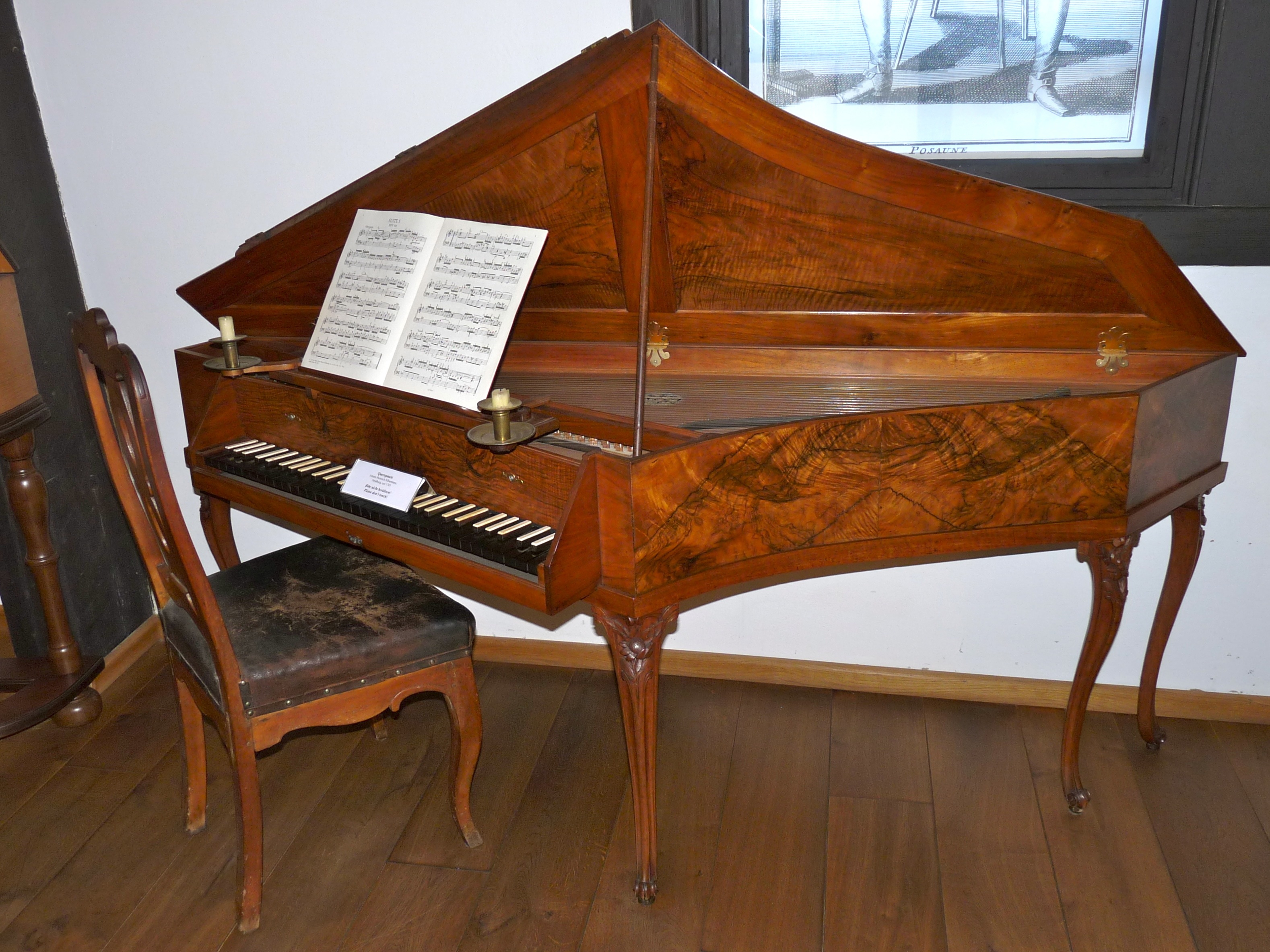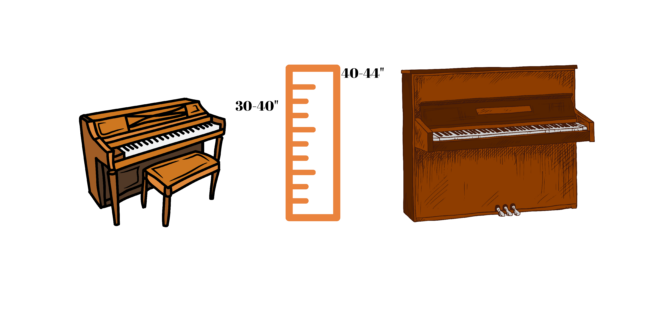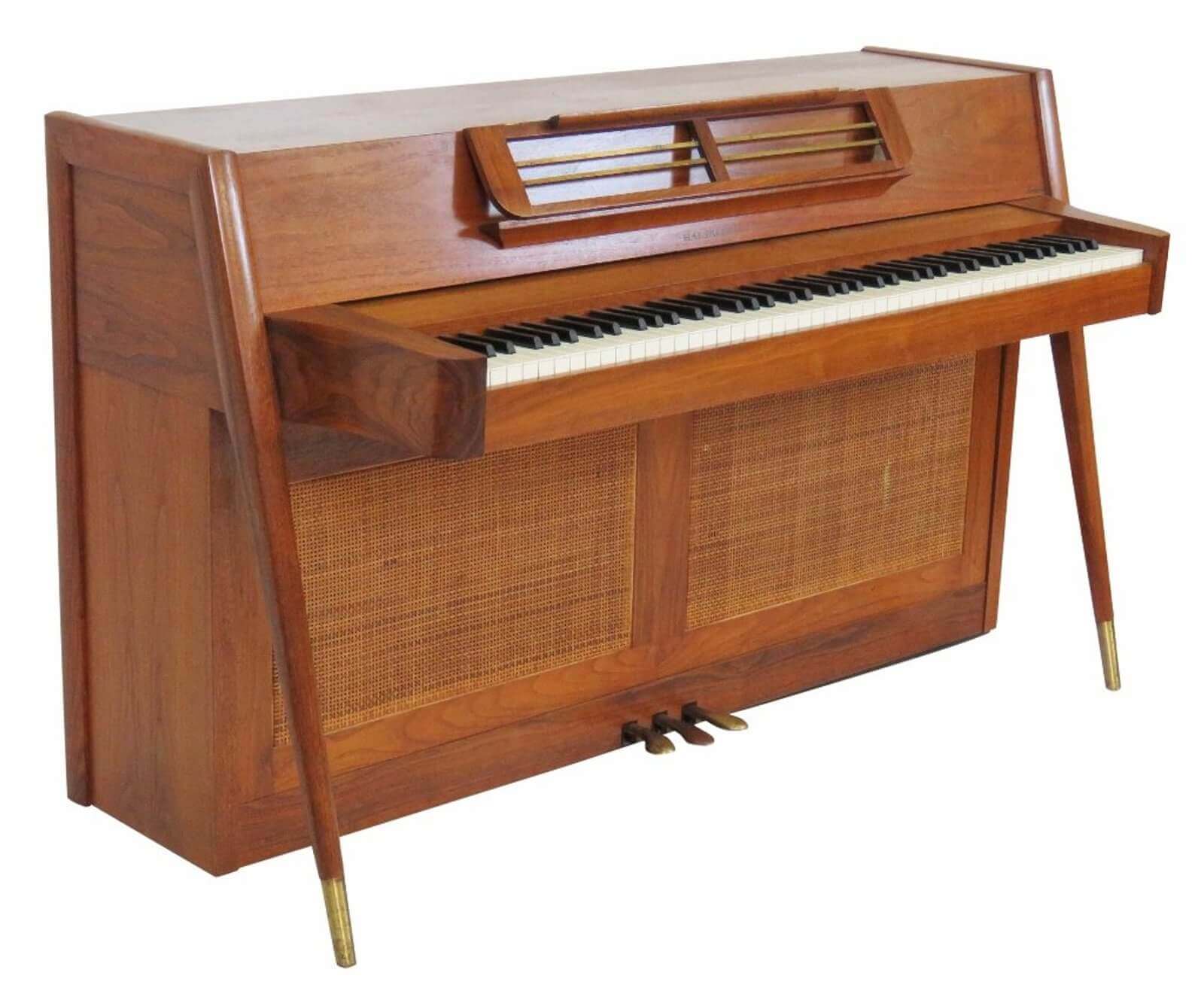A spinet piano is a compact upright piano with a shorter range of keys. It features a smaller soundboard and shorter strings than standard pianos.
Ideal for small spaces and casual players, the spinet piano became popular in the mid-20th century due to its affordability and space-saving design. This instrument typically spans only 36 to 40 inches in height, which allows it to fit into tighter living spaces without dominating the room.
This smaller stature, however, does produce a different tone quality—often described as less resonant—compared to larger uprights and grand pianos. The spinet’s action, known as drop-action or indirect-blow action, is also unique due to the constraints of its compact frame, contributing to its characteristic touch and sound. Despite these differences, spinet pianos have found their place as beginner instruments and in households looking for a piano that doesn’t require a significant amount of space.

Credit: en.wikipedia.org
The Spinet Piano Defined
Imagine stepping back to the era of intimate parlor music sessions. The spinet piano holds a charming place in music history, perfect for small spaces and rich in character. It’s a compact instrument that enchants musicians and audiences alike. Let’s delve into the enchanting world of this miniature marvel!
In the family of stringed instruments, the spinet piano stands out with distinct features:
- Size: It is the smallest of the pianos, ideal for cozy living areas.
- Action: Its action lies below the keys, using a unique mechanism called the drop action or indirect blow action.
- Sound: The spinet produces a softer, more intimate sound compared to larger pianos, due to shorter strings and smaller soundboards.
- Keyboard: The keys span the usual 88 notes, yet retain a compact layout.
The spinet piano’s tale is a narrative of musical evolution:
| Time Period | Development |
|---|---|
| 1930s to 1990s | Spinet pianos became popular for their affordable price and space-saving design, flourishing in American homes. |
| Mid-20th Century | Technological improvements in piano making rendered larger uprights and grand pianos more compact and affordable, overshadowing the necessity of spinets. |
| Modern Day | The vintage quality of spinets continues to allure musicians and collectors, embodying a nostalgic essence. |
Despite its decline in production, the spinet piano has a treasured legacy as an instrument that brought music into the heart of the domestic sphere.
Anatomy Of A Spinet
A spinet piano stands out with its compact size and unique sound. This musical charmer packs more than just melodious tones. It’s an intricate assembly of various components fitting together to produce music. Let’s delve into the anatomy of this delightful instrument.
Key Components And Their Functions
Every spinet is a marvel with numerous parts, each playing a critical role.
- Keyboard – the array of black and white keys you play on.
- Hammers – felt-tipped mechanisms that strike strings, creating sound.
- Strings – metal wires that vibrate to produce musical notes.
- Action – the intricate system linking keys to hammers.
- Case – the outer wooden shell providing structure and aesthetics.
- Pedals – usually one or two that modify the sound’s sustain and dynamics.
Understanding Action Mechanism
The action is crucial for a spinet’s functionality.
This mechanism drives the hammers to hit the strings when you press a key.
| Part | Function |
|---|---|
| Wippens | Elevates the hammer as the key goes down. |
| Jacks | Propels the hammer towards the string momentarily. |
| Dampers | Stops string vibration when you release the key. |
The action in spinets is often referred to as “drop-action” or “indirect blow”.
This is due to the compact vertical orientation of its parts.
It’s distinctive from larger pianos, affecting the touch and responsiveness of the keys.
Comparing Spinets With Other Pianos
The world of pianos is rich with variations in size, sound, and style. Understanding these differences can help one choose the right piano. Let’s dive into how spinets stand out among other pianos.
Spinets Versus Uprights
Spinets and uprights share similarities, but they differ in several key aspects:
- Size: Spinets are the smallest, and uprights are larger.
- Sound: Uprights often offer richer tones compared to spinets.
- Mechanism: Spinets have a different action, called “drop action”.
These differences are due to the height and internal mechanism of the pianos. Spinets are compact and fit small spaces, while uprights are better for larger rooms.
Spinets Versus Grand Pianos
Grand pianos are well-known for their elegance and powerful sound. Here’s how they compare with spinets:
| Design: | Spinets have a vertical design; grands are horizontal. |
| Space: | Grands require more floor space; spinets take less. |
| Performance: | Grand pianos offer superior touch and sound resonance. |
While grand pianos are ideal for concerts, spinets suit private homes due to their size and cost.

Credit: www.hellosimply.com
Pros And Cons Of Choosing A Spinet
A spinet piano, a compact instrument ideal for small spaces, offers affordability and convenience. On the downside, its limited key range and lighter action may not suit advanced players seeking nuanced performance dynamics.
Picking the right piano is a big decision. A spinet piano is small and cute. Let’s explore if it fits your needs.Advantages For Small Spaces
The spinet piano is a perfect fit for tiny places. Its petite size means it takes up less room. This is great for small houses or apartments. You can enjoy playing without a big space.
- Fits into cozy corners
- Doesn’t crowd the area
- Ideal for city living
Limitations In Sound And Playability
Unfortunately, smaller pianos have drawbacks. The spinet’s tiny body impacts its sound. It can’t match the resonance of bigger pianos. Its keys may feel different to play on too.
| Feature | Limitation |
|---|---|
| Sound Quality | Not as rich or deep |
| Key Response | May feel less responsive |
Caring For Your Spinet
Spinet pianos, with their compact size and unique charm, require proper care to maintain their beautiful sound and appearance. Like any valuable instrument, a spinet piano thrives on attention and maintenance. Regular care ensures longevity and a delightful musical experience. Follow these straightforward guidelines to take care of your beloved instrument.
Regular Maintenance Tips
Keeping your spinet piano in top condition involves routine checks and cleaning:
- Dust regularly: Use a soft cloth to gently remove dust from the keys and surfaces.
- Keep it dry: Protect your piano from moisture; never use a damp cloth on the keys.
- Avoid direct sunlight: Keep your piano out of direct sunlight to prevent damage to the wood.
- Monitor room temperature: A consistent temperature and humidity level are crucial.
Tuning And Repairs
For optimal performance, tuning and occasional repairs might be necessary:
- Schedule regular tuning: A professional tuner should tune your piano at least twice a year.
- In case of sticky keys: Contact a technician if keys stick or don’t produce sound.
- Addressing wear and tear: Have any worn out parts repaired or replaced to prevent further damage.
- Invest in professional care: Specialists can identify and fix issues early, saving you from expensive repairs later.

Credit: www.europianosnaples.com
The Fate Of The Spinet In Modern Music
Throughout history, musical instruments evolve with trends and technological advancements. The spinet piano’s journey is no exception. This modestly sized instrument had its heyday but faces a different reception in today’s music scene.
Popularity Trends
In the mid-20th century, spinet pianos were a common sight in many households. Their compact size made them a favorite for small spaces. Yet, as grand and upright pianos became more accessible, the spinet’s prominence waned.
- 1950s to 1970s: Peak popularity due to affordability and size.
- 1980s onwards: Decline as larger pianos became more popular.
- Today: Rarity and niche appeal in vintage circles.
The Spinet In Contemporary Settings
Despite its diminished status, the spinet piano finds a place in contemporary settings. Some musicians value its unique sound for certain styles of music.
| Setting | Usage |
|---|---|
| Home studios: | For intimate and warm tones. |
| Music schools: | Sometimes used for teaching basics. |
| Performance venues: | For specific acoustic requirements. |
In modern music production, digital sampling revives the spinet. Its sound is recorded and used in digital tracks. Artists and producers seek out its vintage charm.
Is a Spinet Piano Considered a Good Piano Brand?
When it comes to best piano brands recommendations, a spinet piano may not be considered at the top of the list. While they can be a good choice for limited space, their smaller size can affect sound quality. It’s important to research and test different brands before making a decision.
Frequently Asked Questions On What Is A Spinet Piano
What Is The Difference Between A Spinet Piano And A Regular Piano?
A spinet piano is a smaller, more compact version of a regular piano, often with a shorter keyboard and a reduced number of keys, typically 88 keys on a regular piano versus 64 to 73 keys on a spinet.
How Can You Tell If A Piano Is A Spinet?
A spinet piano features a compact size, typically standing around 36-40 inches tall and has a shorter keyboard range. Check the piano’s height and look for a drop action mechanism behind the keys, distinguishing it from larger uprights.
What Are The Disadvantages Of A Spinet Piano?
Spinet pianos have a less robust sound due to their small size. Their compact action hampers the touch response and dynamic range. Limited key length affects playing precision. They often possess lesser build quality and can be challenging to service.
Are Spinet Pianos Good For Beginners?
Spinet pianos can be suitable for beginners due to their compact size and affordability. They offer a practical start to learning the piano without a large initial investment.
Conclusion
The spinet piano, with its compact size and distinct sound, offers a unique charm for musicians and enthusiasts alike. Ideal for small spaces, it’s a nod to musical history and practicality combined. Embracing a spinet means enjoying an instrument that’s as decorative as it is functional, a true piece of artistry for any home.
